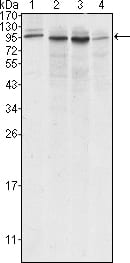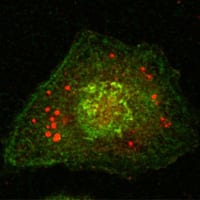

| WB | 1/500 - 1/2000 | Human,Mouse,Rat |
| IF | 咨询技术 | Human,Mouse,Rat |
| IHC | 咨询技术 | Human,Mouse,Rat |
| ICC | 1/200 - 1/1000 | Human,Mouse,Rat |
| FCM | 咨询技术 | Human,Mouse,Rat |
| Elisa | 1/10000 | Human,Mouse,Rat |
| Aliases | CNX; P90; CANX |
| Entrez GeneID | 821 |
| clone | 3H4A7 |
| WB Predicted band size | 90kDa |
| Host/Isotype | Mouse IgG2b |
| Antibody Type | Primary antibody |
| Storage | Store at 4°C short term. Aliquot and store at -20°C long term. Avoid freeze/thaw cycles. |
| Species Reactivity | Human |
| Immunogen | Synthetic peptide corresponding to aa (CEAAEERPWLWVVYILTVAL) of human Calnexin, conjugated to KLH. |
| Formulation | Purified antibody in PBS with 0.05% sodium azide. |
+ +
以下是关于Calnexin抗体的3篇代表性文献摘要,供参考:
---
1. **文献名称**:Calnexin: A membrane-bound chaperone of the endoplasmic reticulum
**作者**:A. Helenius, E.S. Trombetta, D.N. Hebert, J.F. Simons
**摘要**:该综述总结了Calnexin作为内质网关键分子伴侣的功能,阐述其通过识别未折叠蛋白的N-连接糖基化结构,协助蛋白质正确折叠的机制,并讨论其在细胞质量控制中的作用。
---
2. **文献名称**:Calnexin interacts with the SARS-CoV-2 spike protein and regulates viral entry
**作者**:Y. Zhang et al.
**摘要**:研究发现Calnexin通过与新冠病毒刺突蛋白结合,影响其正确构象和膜融合过程,提示Calnexin抗体可用于研究病毒入侵机制及潜在抗病毒靶点开发。
---
3. **文献名称**:Role of calnexin in neurodegenerative diseases linked to ER stress
**作者**:C. Hetz, L.H. Glimcher
**摘要**:该研究揭示了Calnexin在阿尔茨海默病和帕金森病中的双重作用:一方面通过缓解内质网应激保护神经元,另一方面可能参与异常蛋白聚集,为抗体标记病理蛋白提供理论依据。
---
如需具体实验应用(如Western Blot验证),可补充说明进一步筛选。
**Background of Calnexin Antibody**
Calnexin is a 65-kDa chaperone protein primarily located in the endoplasmic reticulum (ER) membrane. It plays a critical role in glycoprotein folding and quality control by binding to newly synthesized monoglycosylated proteins via its lectin domain. Calnexin retains incompletely folded or misfolded proteins in the ER, facilitating their proper folding through interactions with ERp57. a thiol-disulfide oxidoreductase, and the UDP-glucose:glycoprotein glucosyltransferase (UGGT)-mediated reglucosylation cycle. It also collaborates with calreticulin, a soluble homolog, to ensure glycoprotein maturation.
Calnexin antibodies are widely used as markers for ER-specific studies. These antibodies enable the detection of calnexin in various applications, including Western blotting, immunofluorescence, and immunoprecipitation, helping researchers investigate ER stress, protein folding mechanisms, and ER-associated degradation (ERAD). Due to calnexin’s transmembrane nature, sample preparation often requires membrane protein extraction methods (e.g., using detergents) to ensure accurate detection.
In disease research, calnexin dysregulation has been linked to neurodegenerative disorders (e.g., Alzheimer’s), cancer (e.g., altered expression in tumors), and viral infections (e.g., involvement in viral glycoprotein processing). Antibodies against calnexin thus serve as vital tools for exploring its role in cellular homeostasis and pathology. Commercial calnexin antibodies are typically raised in hosts like rabbits or mice, targeting conserved regions (e.g., C-terminal domains) to ensure cross-reactivity across human, mouse, and rat samples. Validation via knockout controls or siRNA silencing is recommended to confirm specificity.
×